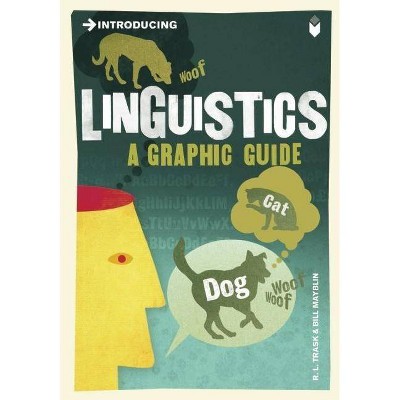The Syntax Workbook - (Introducing Linguistics) 2nd Edition by Andrew Carnie (Paperback)

Similar Products
Products of same category from the store
AllProduct info
<p/><br></br><p><b> About the Book </b></p></br></br>"1) Workbook Exercises (WBE): This workbook contains enrichment and additional practice exercises that go along with each chapter in the book. You can check your own answers against the answer key at the end of each chapter. 2) General Problem Sets (GPS) (in the main textbook): You can do the general problem sets at the end of each chapter in the main textbook. I'm sorry but the answers to these questions are not made available to students. The reason for this is that many instructors use these problem sets as a means for student evaluation. Providing the answers to these would be counterproductive! If you are using the textbook for self-study or your instructor isn't using the problem sets for evaluation, I encourage you to find a linguistics professor or linguistics (post-)graduate student who can help you with determining if you are on the right track with these. 3)If you are an advanced student or a graduate student, I strongly encourage you to try the Challenge Problem Sets (CPS) at the end of each chapter in the main textbook. These problem sets are designed to make you think critically about the presentation in the text and to think about alternatives and problems that exist for the theory. Again the answers to these cannot be distributed to students"--<p/><br></br><p><b> Book Synopsis </b></p></br></br><p><b>A valuable companion to Andrew Carnie's </b><b><i>Syntax: A Generative Introduction, 4th Edition, </i>full of practice questions and engaging exercises to promote student comprehension </b> </p> <p><i>Syntax: A Generative Introduction, Fourth Edition, </i> is the leading textbook for undergraduate courses in the syntax, covering foundational topics such as universal grammar, parts of speech, constituency, trees, structural relations, binding theory, x-bar theory, and movement, as well as advanced subjects such as control theory, ellipsis, polysynthesis, incorporation, non-configurationality, and Merge<i>. </i>Written by <i>Syntax</i> author Andrew Carnie, <i>The Syntax Workbook</i> has been purposefully designed to support and complement the use of Syntax in the undergraduate classroom. <i>The Syntax Workbook</i> is the perfect companion to the author's seminal textbook and contains updated practice material for every section of the text. This workbook: </p> <ul> <ul> <ul> Includes exercises, practice questions, data analysis, and knowledge application questions for each section in <i>Syntax: A Generative Introduction, Fourth Edition</i> </li> Features exercises and questions with full answers and explanations to assist students in learning to apply theory to practice </li> Has been authored by leading figure in syntax Andrew Carnie to support classroom usage of <i>Syntax: A Generative Introduction, Fourth Edition</i> </li> Works in concert with a student companion website, offering a robust selection of learning tools for the classroom </li> </ul> </ul> </ul> <p>Ideal for undergraduate courses in syntax, <i>Syntax: A Generative Introduction, Fourth Edition, </i>and <i>The Syntax Workbook, Second Edition, </i> together offer a perfect combination of thorough coverage and valuable practice. The workbook can be purchased on its own or in a set with the textbook. <br /><br />Available as a set with <i>Syntax: A Generative Introduction, 4th Edition</i></p><p/><br></br><p><b> From the Back Cover </b></p></br></br><p><i>Syntax: A Generative Introduction, Fourth Edition</i>, is the leading textbook for undergraduate courses in syntax, covering foundational topics such as universal grammar, parts of speech, constituency, trees, structural relations, binding theory, X-bar theory, and movement, as well as advanced subjects such as control theory, ellipsis, polysynthesis, incorporation, non-configurationality, and Merge. <i>The Syntax Workbook</i> is the perfect companion to the author's seminal textbook and contains updated practice material for every section of the text. Together, this set of texts has helped a generation of new syntacticians to understand the elements of the study of syntax and to develop their understanding through thoughtfully crafted practice questions and exercises. <p>Written by <i>Syntax</i> author Andrew Carnie, <i>The Syntax Workbook</i> has been purposefully designed to support and complement the use of <i>Syntax</i> in the undergraduate classroom. Fully updated and revised throughout, the new edition of the workbook includes exercises, practice questions, data analysis, and knowledge application questions for each section in <i>Syntax</i>. With a close focus on assisting students in learning to apply the theory and principles described in <i>Syntax</i>, the workbook features exercises and questions with full answers and explanations. In addition, students will have access to a student companion website. <p>Ideal for undergraduate courses in syntax, <i>Syntax: A Generative Introduction, Fourth Edition</i>, and <i>The Syntax Workbook, Second Edition</i>, together offer a perfect combination of thorough coverage and valuable practice.<p/><br></br><p><b> About the Author </b></p></br></br><p><b>Andrew Carnie</b> is Vice Provost for Graduate Education, Dean of the Graduate College, and Professor of Linguistics at the University of Arizona, USA. He specializes in generative syntactic theory with an emphasis on constituency, VSO languages, copular constructions, and the Celtic Languages. He is the author of numerous publications, including <i>Constituent Structure, Modern Syntax, and Syntax: A Generative Introduction, Fourth Edition</i>, and is the co-editor of <i>The Routledge Handbook of Syntax</i>.
Price History
Price Archive shows prices from various stores, lets you see history and find the cheapest. There is no actual sale on the website. For all support, inquiry and suggestion messagescommunication@pricearchive.us




















